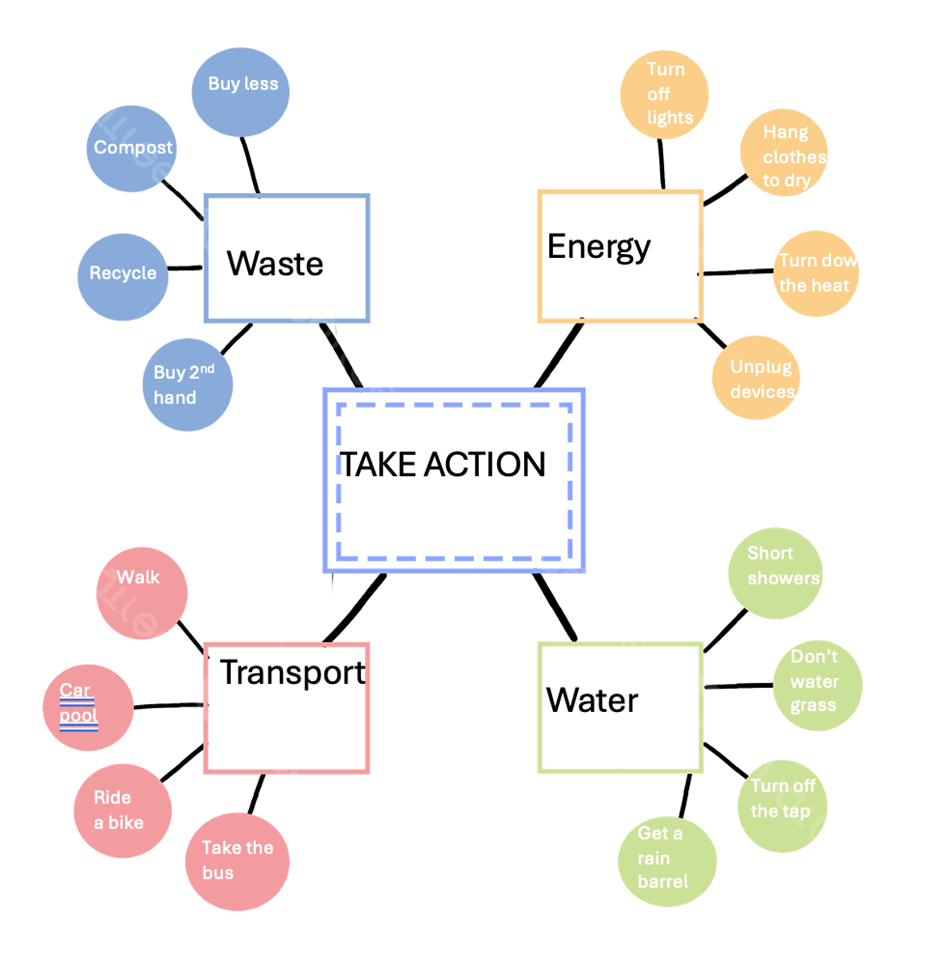Nature art for eco-hope
Connect with nature to discover ways to help our planet and take action on climate change.

Overview
In this activity students connect with nature by drawing outdoors to both foster awareness and emotionally process their feelings about the climate. Students then go back inside to create an art gallery to reflect on and share their experiences in nature. From here they can understand how to reduce electricity by using nature to help. Finally, the class creates a mind map to empower them to take action on climate change and contribute to eco-hope.
Instructions
What you'll need
- “Connect with nature” student handout, print one copy per student
- Pencil and coloring crayons or markers, per student
- Clip board or similar, one per student
1. Start the activity by having a class discussion about climate change, climate anxiety and eco-hope and/or do the activity “How do you feel about climate change”
2. Share with students that going out into the forest and greenspace can help reduce climate anxiety and make us feel calmer. It also can be a place of discovery, inspiring us to take meaningful action and contribute to climate change solutions.
Connect with nature
3. Tell students we will go outside to capture nature by drawing a scene that we see. Share that nature is things like trees, plants, animals, clouds and rain. They are not people-made things like buildings or cars. After completing their drawings, students are invited to turn the page and follow simple prompts: close their eyes to listen, gaze at the sky, stand beneath a tree, and run on the spot. These activities can help them connect with nature more deeply and engage with the elements of their natural environment. They can record their experience on the handout.
4. Provide each student with a copy of the “Connect with nature” student handout, a clip board or similar, pencil and coloring crayons or markers.
5. Dress for the weather, power down the classroom and head outside to draw and experience nature.
Reflect
6. After completing their drawings and recording their answers have students come back inside and create an art gallery in the classroom to share their pictures. Invite students to add a title and (optionally) a short description to their pictures. Set up the classroom art gallery with as much detail as you prefer. Decorate the classroom, set up spotlights on their artwork, create gallery opening invitations, provide snacks and drinks, etc.
7. Students then can do a ‘gallery walk’ ato view the other pictures while reflecting on their experience of connecting to nature, how it made them feel and considering the outside effects of light, sound and temperature. Encourage them to have discussions with other students about the art they see, or leave post-it note comments about how the art pieces made them feel as they walk around.
8. Gather everyone back together again. Ask students what it means to be comfortable in the natural environment and have them share how nature can help us be and stay comfortable. They may share that the sun provides light and can keep us warm and trees can help us stay cool in summer and shelter us from wind and rain.
9. Discuss that inside our school and homes often electricity helps us to control our environment, so we are comfortable. In B.C. our electricity is powered by BC Hydro which is clean renewable energy. Hydroelectricity powers our lights, our appliances and devices, heats many homes and can keep us cool in summer. However, it’s important not to waste energy and we can use nature to help us reduce our electricity indoors. Have students share ways we can ‘power off’ by using nature to help us like opening blinds/curtains and turning off the lights, putting on a sweater and turning down the heat, opening blinds and curtains to let sunlight in and provide warmth in winter, but close them on hot summer days to keep the sun's heat out.
10. There are many ways we can take action to conserve energy and hence mitigate climate change. Taking action with climate solutions that are within our control helps reduce anxiety and feelings of helplessness over climate change. Share that these were ways to conserve electricity but there are other positive changes we can all make.
Create a mind map
11. Share that as a class we will create a mind map/brain dump to capture these positive changes and take action.
12. Copy this template on to the board so all the students can see, writing “take action” in the center and using the four headings “waste, energy, water and transport”.

13. Using the “think, pair, share strategy”, (where students think on their own, share their ideas with a friend, and then share as a class) have students propagate ideas and solutions to take action on our environment and combat climate change. Write some of the ideas the class share on the mind map under the relevant category.
14. Here are a few of our ideas:

Modify or extend this activity
- Continue this unit with the next activity: “Mindfulness for battling climate anxiety”.
- Individually or as a class review the ideas and make a commitment to one or two actions out of each category.
Curriculum Fit
Physical health and education (4-7)Big ideas
Curricular Competency
Arts Education (4-7)Big idea
Content
Curricular Competency
|
Assessments
- Assess students’ creativity and connection to nature with the drawing activity.
- Assess students’ participation in the mind map generation.
- Assess students’ social awareness and responsibility in mitigating climate change and taking care of the environment.
Teaching Notes
Understanding climate anxiety
Excerpt from the Mental Health and Climate Change Alliance.
“Climate change isn’t just an environmental issue—it’s also an emotional one for many young people. Children and teens today are acutely aware of climate threats, and this awareness often comes with intense feelings. In a recent international survey of 10,000 youth (ages 16–25), nearly 60% said they feel “very” or “extremely” worried about climate change, with almost half saying these worries negatively affect their daily lives. Canadian youth echo these concerns: in one national study, 73% of young Canadians said the future feels “frightening” due to climate change, and nearly half believed “humanity is doomed”. Over three-quarters reported that climate change impacts their overall mental health, and 4 in 10 said their climate-related feelings have a negative effect on their daily life. Clearly, climate change is no distant abstraction for our kids – it’s a real source of stress, anxiety, and even despair in their lives”.
Building eco-hope
Strategies to build eco-hope include connecting with nature and your community, focusing on controllable actions and small wins, channeling emotions into positive action, and educating yourself and others about environmental issues. Engage with inspiring environmental campaigns, join local groups, practice self-compassion, and limit overwhelming climate news to avoid burnout.
BC Hydro takes action on climate change
BC Hydro is taking action on climate change by working within the provincial CleanBC plan to increase the supply of clean electricity, improving energy efficiency, and reducing the carbon impact of its own operations. Key initiatives include adding renewable energy sources through calls for power, investing significantly in energy efficiency programs for customers, and reducing greenhouse gas (GHG) emissions from its own buildings, fleet, and equipment.







